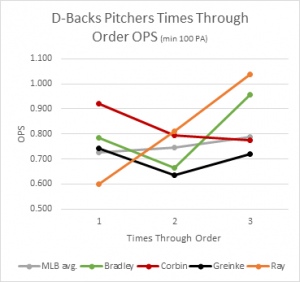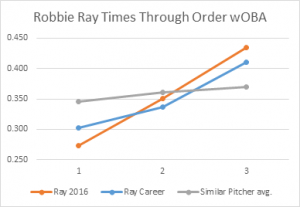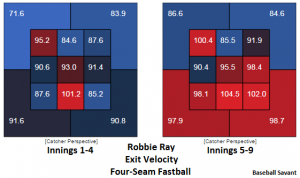Summertime in Phoenix is not what you want. The heat is grating and aside from Pokémon Go, there is no reason to go outside. Pool water turns to bath water and by August, we’re all essentially quarantined within our concrete and air conditioned structures. It can be relatively easy for one to forget that temperatures are actually allowed to be two digits in magnitude. But every now and then, the seemingly endless sun gives way to clouds, and every now and then, those clouds produce rain. For most, it is a most welcomed reprieve. Something that breaks up the heat.
Implying that 2016 has been a stormy season for the Diamondbacks wouldn’t be very fitting considering the setting. Calling it a hot mess would probably be a bit more appropriate, as to not juxtapose the welcomed monsoon storms with the unwelcomed storms of the Diamondbacks’ season. Nevertheless, between the failures and disappointments of the season are brief times of reprieve. Things that remind you why you love baseball and give meaning to the games of a team whose demise and destiny are all too apparent – things that make the plod more endurable.
 At times, Robbie Ray has filled that void. As someone who probably deserves better outcomes than the ones he’s been given, those times ought to happen more frequently. However, there’s a discernible pattern to both his greatness and his struggles. He, more than any other pitcher for the team, falls victim to the times through the order (abbreviated as TTO) penalty. It’s not a groundbreaking discovery anymore that pitchers get worse as the game goes on and batters see more of a pitcher, but Robbie’s struggle have been magnified in this regard. Certainly, these trends for all the Diamondbacks pitchers are quite volatile. A pitcher’s career TTO numbers don’t really have much predictive value but there are some factors that can lead to some variance: Notably, pitches seen by an individual batter and pitch repertoire.
At times, Robbie Ray has filled that void. As someone who probably deserves better outcomes than the ones he’s been given, those times ought to happen more frequently. However, there’s a discernible pattern to both his greatness and his struggles. He, more than any other pitcher for the team, falls victim to the times through the order (abbreviated as TTO) penalty. It’s not a groundbreaking discovery anymore that pitchers get worse as the game goes on and batters see more of a pitcher, but Robbie’s struggle have been magnified in this regard. Certainly, these trends for all the Diamondbacks pitchers are quite volatile. A pitcher’s career TTO numbers don’t really have much predictive value but there are some factors that can lead to some variance: Notably, pitches seen by an individual batter and pitch repertoire.
As a general rule, from first to third TTO, the more fastballs a pitcher throws, the harsher the penalty will be. Mitchel Lichtman did some great research over at Baseball Prospectus a few years ago, showing this. Pitchers who throw fastballs over 75% of the time see about a 34 (.034) point penalty in their wOBA between their first and third TTO, and for a pitcher who throws fastballs less than 50% of the time, the penalty drops sharply to 14 points of wOBA. Robbie Ray is in the happy middle ground, consistently throwing fastballs at a 70% rate. For pitchers similar to Ray, which is roughly 84% of starting pitchers Lichtman found their penalty to be about 24 points. Ray has had a far wider range this season, nearly seven times greater than what would be expected, to be specific. In an almost linear fashion, his TTO penalty from first to second time is 78 points of wOBA and from second to third his wOBA allowed jumps by 83 points – that’s a whopping wOBA differential of .161 from his first to third TTO.
 Over his career in the majors, beginning three seasons ago in 2014, Robbie Ray has consistently been one of the most inefficient pitchers in baseball. He averaged the most pitches per plate appearance last season and ranks 13th this season for qualified pitchers – coincidentally, had he qualified in 2014, he would have ranked 13th that season also. Here, it’s important to disclaim that Lichtman also laid out: “A pitcher’s career ‘times through the order’ patterns have almost no predictive value. We can assume that all starting pitchers have roughly the same ‘true talent’ TTO (penalty), regardless of what they have shown in the past.” However, he later goes on to show that the number of pitches seen by a batter can be quite important: “For an individual batter, the number of pitches seen makes a huge difference. The largest difference is from the first to the second time through the order. If a batter sees fewer than three pitches in his first PA, he hits 10 points (of wOBA) better his second time at the plate. If he sees more than four pitches his first time up, he hits 25 points better on his second go-around!” For his career, Ray has a difference of about 33 points in his wOBA between first and second TTO, but he has also consistently been an outlier in terms of pitches thrown. He’s never averaged less than 4 pitches thrown per plate appearance and has a career average of 4.08. While Ray’s extreme penalty of 78 points between his first and second TTO this season seems bound for some regression, it’s certainly not unreasonable to see him as someone who might suffer a greater penalty than normal, given his inefficiency. Though his career differential of 33 points is likely a bit high, that would undoubtedly be closer towards the realm of normalcy.
Over his career in the majors, beginning three seasons ago in 2014, Robbie Ray has consistently been one of the most inefficient pitchers in baseball. He averaged the most pitches per plate appearance last season and ranks 13th this season for qualified pitchers – coincidentally, had he qualified in 2014, he would have ranked 13th that season also. Here, it’s important to disclaim that Lichtman also laid out: “A pitcher’s career ‘times through the order’ patterns have almost no predictive value. We can assume that all starting pitchers have roughly the same ‘true talent’ TTO (penalty), regardless of what they have shown in the past.” However, he later goes on to show that the number of pitches seen by a batter can be quite important: “For an individual batter, the number of pitches seen makes a huge difference. The largest difference is from the first to the second time through the order. If a batter sees fewer than three pitches in his first PA, he hits 10 points (of wOBA) better his second time at the plate. If he sees more than four pitches his first time up, he hits 25 points better on his second go-around!” For his career, Ray has a difference of about 33 points in his wOBA between first and second TTO, but he has also consistently been an outlier in terms of pitches thrown. He’s never averaged less than 4 pitches thrown per plate appearance and has a career average of 4.08. While Ray’s extreme penalty of 78 points between his first and second TTO this season seems bound for some regression, it’s certainly not unreasonable to see him as someone who might suffer a greater penalty than normal, given his inefficiency. Though his career differential of 33 points is likely a bit high, that would undoubtedly be closer towards the realm of normalcy.
Perhaps less explainable is Ray’s inexplicably awful penalty between seeing the order a second and third time. Over his career, the penalty is about 74 points of wOBA, but this season it’s somehow spiked to a gaudy 84 points. While the more pitches seen by a batter the first time through unquestionably skews outcomes towards the batter’s favor the second time around, that’s about where it stops. The third time around, a batter who’s seen many pitches has a 2 point advantage over a batter who has seen only a few pitches. While there is likely a lot of variance that ought to regress, Ray’s approach might be a factor as well.

Baseball Savant, and therefore Statcast, data isn’t sortable by TTO, but I sorted the data by innings to try and achieve the a compatible replacement, with the first through fourth innings typically consisting of the first and second TTO and the fifth inning on containing mostly the third TTO. Ray’s faced only five batters four times in a game so there isn’t much room for concern in regards to back-end pollution by including later innings. It’s not perfect, but it’s as good as things are going to get.
Regarding at his pitch usage,  there isn’t much difference in how much Ray is utilizing the different pitches in his repertoire. The only difference of note is that the third TTO, he tends to move away from his two-seam fastball and becomes more reliant on his four-seamer as compensation. What’s interesting is that this move towards the four-seam fastball appears to be rather counterproductive. Earlier this year I looked at how fastball woes had been plaguing the Diamondbacks rotation and Robbie Ray was seemingly the only one not being affected. Indeed, his four-seam fastball has been his best pitch, with his wFA/100 being .70 – meaning, he is .70 runs above average for every 100 four-seamers thrown. However, much of this value appears to come early in games.
there isn’t much difference in how much Ray is utilizing the different pitches in his repertoire. The only difference of note is that the third TTO, he tends to move away from his two-seam fastball and becomes more reliant on his four-seamer as compensation. What’s interesting is that this move towards the four-seam fastball appears to be rather counterproductive. Earlier this year I looked at how fastball woes had been plaguing the Diamondbacks rotation and Robbie Ray was seemingly the only one not being affected. Indeed, his four-seam fastball has been his best pitch, with his wFA/100 being .70 – meaning, he is .70 runs above average for every 100 four-seamers thrown. However, much of this value appears to come early in games.
Seeing as the average exit velocity for his four-seam fastball jumps from 88.9 MPH over the first four innings to 94.1 from the fifth on, it appears that by the third TTO, hitters have picked up on it quite a bit. Looking at exit velocity charts, 12 of the 13 sections of the strike zone see hitters improving their contact the third time around. Perhaps exacerbating the issue is the locating of his four-seam fastballs. Ray moves away from utilizing both sides of the plate to throwing almost solely middle-middle. Though this allows him to keep a low walk rate of 6.2% third TTO, he’s throwing a lot of pitches where guys are hitting them the hardest. While some effectiveness with the fastball can assuredly be expected to lessen as the game goes on, the adjustment made by Ray to compensate for that does not appear to be a prudent one. Throwing more of a pitch that guys have seen more of to spots they can reach it better is, well, not what you want.
All of this isn’t to suggest Robbie Ray has found the secret worsening the through the order penalty. There’s probably a mix of both with the truth being he’s been fairly unlucky but nonetheless hasn’t helped his own cause.
Given what we know about the penalty, thanks to Mr. Lichtman, Robbie Ray is likely due for some regression, the good kind in this case. He’s improved his performances early in games and has been a strikeout machine. Though he probably isn’t as bad as he’s been later in games, there is some room for improvement in both efficiency and approach. Nevertheless, he’s been a pretty fun guy to watch in a rather unfun season. Hopefully, he’ll find a reprieve from his later inning struggles soon enough.
One Response to Diminishing Ray-turns: A Look at Robbie Ray’s Later Inning Struggles
Leave a Reply Cancel reply
Recent Posts
@ryanpmorrison
 Best part of Peralta’s 108 mph fliner over the fence, IMHO: that he got that much leverage despite scooping it out… https://t.co/ivBrl76adF, Apr 08
Best part of Peralta’s 108 mph fliner over the fence, IMHO: that he got that much leverage despite scooping it out… https://t.co/ivBrl76adF, Apr 08 RT @OutfieldGrass24: If you're bored of watching Patrick Corbin get dudes out, you can check out my latest for @TheAthleticAZ. https://t.co/k1DymgY7zO, Apr 04
RT @OutfieldGrass24: If you're bored of watching Patrick Corbin get dudes out, you can check out my latest for @TheAthleticAZ. https://t.co/k1DymgY7zO, Apr 04 Of course, they may have overtaken the league lead for outs on the bases just now, also...
But in 2017, Arizona ha… https://t.co/38MBrr2D4b, Apr 04
Of course, they may have overtaken the league lead for outs on the bases just now, also...
But in 2017, Arizona ha… https://t.co/38MBrr2D4b, Apr 04 Prior to the games today, there had only been 5 steals of 3rd this season (and no CS) in the National League. The… https://t.co/gVVL84vPQ5, Apr 04
Prior to the games today, there had only been 5 steals of 3rd this season (and no CS) in the National League. The… https://t.co/gVVL84vPQ5, Apr 04 RT @OutfieldGrass24: Patrick Corbin has a WPA of .318 and it's only the fifth inning., Apr 04
RT @OutfieldGrass24: Patrick Corbin has a WPA of .318 and it's only the fifth inning., Apr 04
Powered by: Web Designers@outfieldgrass24
 This Suns matchup comes at a good time for my hometown Blazers #RipCity https://t.co/fQ45wdfQUk, 5 hours ago
This Suns matchup comes at a good time for my hometown Blazers #RipCity https://t.co/fQ45wdfQUk, 5 hours ago RT @ZHBuchanan: Our @Ken_Rosenthal spoke to Ken Kendrick about trading Paul Goldschmidt.
https://t.co/O5fHRlyBxD, 12 hours ago
RT @ZHBuchanan: Our @Ken_Rosenthal spoke to Ken Kendrick about trading Paul Goldschmidt.
https://t.co/O5fHRlyBxD, 12 hours ago RT @CardsNation247: We have a good show lined up for tonight. Leading off is our friend of the show @buffa82 followed by Jeff Wiser… https://t.co/eltZC0uvyg, 12 hours ago
RT @CardsNation247: We have a good show lined up for tonight. Leading off is our friend of the show @buffa82 followed by Jeff Wiser… https://t.co/eltZC0uvyg, 12 hours ago RT @juanctoribio: To piggyback off the @ZHBuchanan and @OutfieldGrass24 that the #Rays were involved in the Paul Goldschmidt sweepsta… https://t.co/spg9x7X1L5, 12 hours ago
RT @juanctoribio: To piggyback off the @ZHBuchanan and @OutfieldGrass24 that the #Rays were involved in the Paul Goldschmidt sweepsta… https://t.co/spg9x7X1L5, 12 hours ago RT @OJCarrascoTwo: Read this from the world famous, @OutfieldGrass24 https://t.co/cHUie1I5Le, 12 hours ago
RT @OJCarrascoTwo: Read this from the world famous, @OutfieldGrass24 https://t.co/cHUie1I5Le, 12 hours ago
Powered by: Web Designers





Seems like his issue is similar to Archie’s; they both lack a solid third pitch.